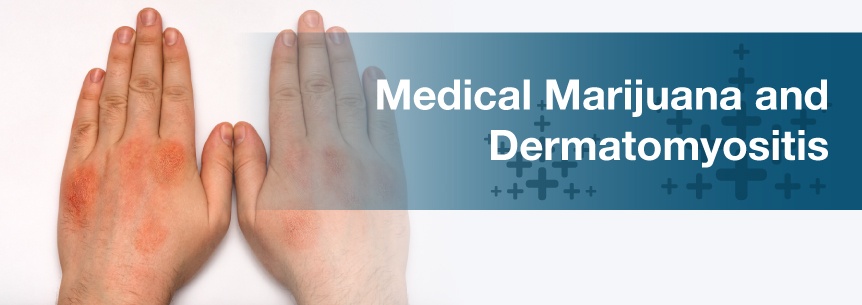
Dermatomyositis is a rare inflammatory disease characterized by muscle weakness and a rash. As you may know already, marijuana is good medicine for inflammation and the pain that often goes along with it. But did you know the compounds in this plant can regulate immune cell activity too? There’s a lot of science behind the cannabis plant, and researchers are finding more and more of what the herb can do medicinally, including medical marijuana for dermatomyositis.
Dermatomyositis (DM) has a distinctive rash, which makes it easy to detect. It usually affects adults in their late 40s to early 60s, according to the Genetic and Rare Diseases Information Center (GARD), but it can also affect children as well, often appearing between the ages 5 and 15. Women tend to develop this condition more than men.
Dermatomyositis doesn’t have a cure, but you can experience remission where you’ll have an improvement in your symptoms or will have no symptoms at all. When you’re experiencing a flare-up — meaning your symptoms are back — there are treatment options to help you regain muscle function and strength, clear the rash and help with other symptoms.
Skin changes and muscle weakness are the two primary symptoms you may notice. It’s easy to spot a DM rash because it’s red or purple and patchy. It appears most commonly on your eyelids or in places you use your muscles for straightening joints such as your knees, toes, knuckles and elbows. You can also get it on your chin, cheeks, nose, upper chest and back.
The first sign of DM is typically the rash. You could get other rashes as well that are usually red and appear on your shoulders, face, upper chest, neck or back. It might look like you have a sunburn and your skin will feel dry, scaly and rough.
Other symptoms you might experience are:
DM is a type of myositis, which is inflammation of the muscles used to move your body. Dermatomyositis is the easiest to diagnose since often the patient will experience the skin rash before they feel any muscle weakness or pain.
Some individuals have calcinosis or hardened bumps under their skin. This symptom might appear one to three years after you develop your first symptoms. Calcium deposits are more likely to occur in children than in adults.
Swelling and inflammation under the skin in the muscles and blood vessels cause weak muscles and the skin rash. The weakness starts with the muscles within and closest to the trunk of your body, including your shoulders, back, neck and hips.
Some people with dermatomyositis also experience muscle pain.
The muscle weakness associated with dermatomyositis can become worse over time. You’ll experience this first in your muscles like your shoulders, neck, upper arms, hips and thighs. You might also experience joint pain, feel weak on both sides of your body and have thinning muscles.
The exact cause of DM is unclear, but, as with other autoimmune disorders, your immune system attacks the tissues of your body by mistake. Specifically, DM affects the small blood vessels in your muscular tissue. Inflammatory cells begin surrounding your blood vessels and gradually destroy your muscle fibers.
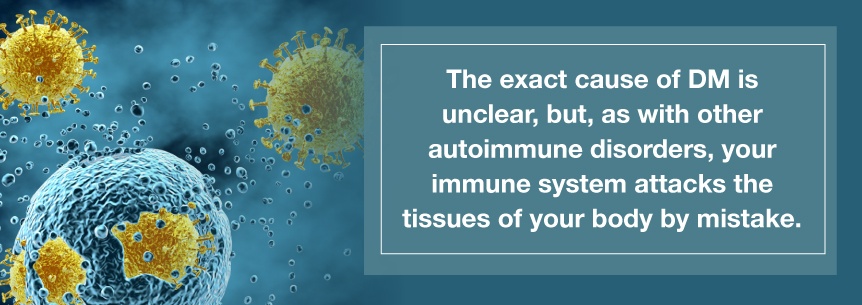
There are different types of DM including:
Besides a rash and muscle weakness, dermatomyositis can lead to other potential complications, including:
DM could also increase your risk of developing other conditions, including:
Individuals with dermatomyositis often have a reduced quality of life. There’s an increased prevalence of mental disorders in dermatology patients with 17.2 and 10.1 percent of them having anxiety and depression, respectively, according to a study published in the Journal of the American Academy of Dermatology (JAAD).
According to some studies, there’s a strong link between major depressive disorder and peripheral inflammation with a higher prevalence of depression in individuals with inflammatory diseases.
Dermatomyositis Statistics
Facts about Dermatomyositis according to American Family Physician (AFP) include:
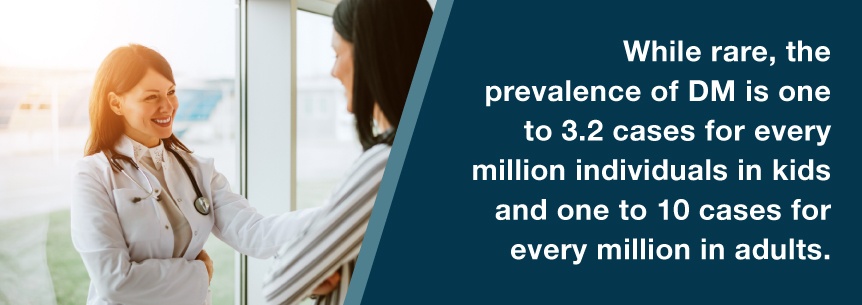
While Unverricht and Wagner receive credit with the first dermatomyositis descriptions in the later 1880s, Unverricht suggested the first one to recognize the disease’s clinical features was Virchow. Virchow already observed a patient in 1866 he described as “spotted with a rash” who made him think of polymyositis.
Your doctor will perform a physical exam and ask about your medical history and symptoms. DM is fairly easy to diagnose because of its associated rash.
The doctor might also order:
There is no cure for dermatomyositis, but treatment can improve your muscle weakness and the condition of your skin. Treatments may include the following:
Corticosteroids, like prednisone, are typical first-line treatment. You apply them to your skin or take them by mouth. They lower your immune system response, reducing the antibodies that cause inflammation. Corticosteroids are not meant to be a long-term treatment since they can produce some serious side effects, including:
Corticosteroid-sparing medications help reduce corticosteroids’ side effects. You can take drugs like methotrexate and azathioprine in advanced cases of DM or if you’re experiencing complications from corticosteroids. There are few side effects of these medications, including:
Depending on how severe your symptoms are, the doctor may suggest:
With dermatomyositis, your body produces antibodies targeting your muscles and skin. IVIG blocks these antibodies using healthy antibodies. IVIG contains a mixture of antibodies collected by the donation of blood from thousands of healthy individuals. The doctor administers IVIG to you through an IV.
Your doctor may recommend surgery to prevent recurrent skin infections and remove painful calcium deposits.
Researchers supported by Muscular Dystrophy Association (MDA) are studying the underlying mechanisms causing inflammatory myopathies like dermatomyositis.
A few MDA projects center around learning what causes the immune system to attack muscle tissue mistakenly. The overall goal is stopping these attacks.
Some researchers funded through the MDA are developing cellular models of dermatomyositis-related muscle injury. The researchers are screening the models to get an understanding of the basic mechanisms behind the disease-causing muscle injury.
They’re putting a lot of focus on the role of interferons. These are proteins the immune system cells typically produce when responding to a viral infection in DM. Some evidence shows in DM, type 1 interferons injure muscle and researchers are looking to discover compounds to prevent such injury.
Tetrahydrocannabinol (THC) suppressed the immune systems of rodents in one study. If the same thing occurred in humans, it could improve the likelihood of using medical cannabis for dermatomyositis.
THC uses the CB1 and CB2 cannabinoid receptors to mediate its activity. CB1 expresses highly in the brain and peripheral tissues at a lower extent, while CB2 dominates the immune cells. So, aside from THC’s psychoactive effects, it activates immune cell cannabinoid receptors through multiple pathways to suppress inflammation.
Humans have natural cannabinoid receptors, which is one reason the cannabinoids in cannabis work so well. Cannabidiol (CBD) helps support your immune system by allowing the self-defense system of your body to recognize the difference between foreign bodies and normal anatomy.
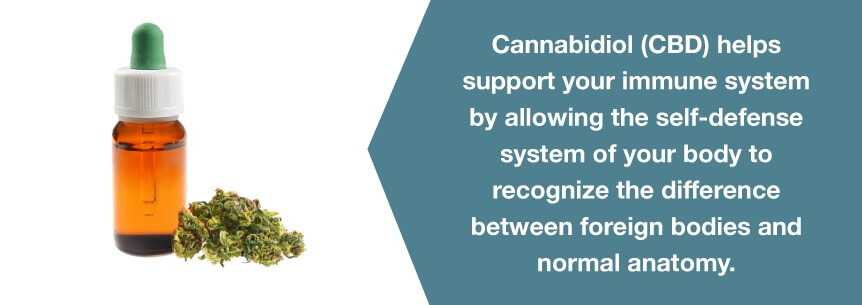
Compounds in medical marijuana activate the body’s and brain’s receptors regulating immune cell activity and inflammation.
Since cannabinoids and hemp can help heal dry skin or rashes, skin areas affected by autoimmune diseases like dermatomyositis may be soothed by lotions or salves made with cannabis. Cannabis can also help ease the pain in connective tissues you can experience with an autoimmune disease.
A study found many recognize the cannabinoid system as a regulator of both immune and nervous systems. Evidence shows the THC found in cannabis is immunosuppressive in both in vitro and in vivo. So, marijuana has immunosuppressive properties that may benefit those suffering from autoimmune diseases.
Many individuals mistakenly believe medical weed merely distracts them from the symptoms of their condition. But, marijuana has compounds that engage directly with immune cells, creating real and valuable body changes. This is why marijuana is effective in calming swelling and inflammation and tackling autoimmune diseases. Researchers have found it all involves your endocannabinoid system.
Cannabis can help relieve symptoms of dermatomyositis including:
Marijuana doesn’t just relieve pain and other symptoms of inflammatory diseases like DM, it also works as an effective immunomodulator. This is a chemical agent that modifies the immune response or immune system functioning.
Many medical pot strains will tackle individual symptoms, while others will tackle most if not all symptoms. For instance, some strains to help ease most if not all DM symptoms including anxiety and depression are:
So, while you’re testing out different strains, you’ll eventually find some will work better than others.
Which delivery method you choose will depend on the symptoms you’re experiencing. Not to worry, there are many options you can experiment with to find the best one. Some include:
You might find a topical in the form of a cream, balm or salve might be the best method to apply cannabis to your rash and find relief. Smoking cannabis is not the optimal choice because of its respiratory effects, particularly if you have compromised lung function.
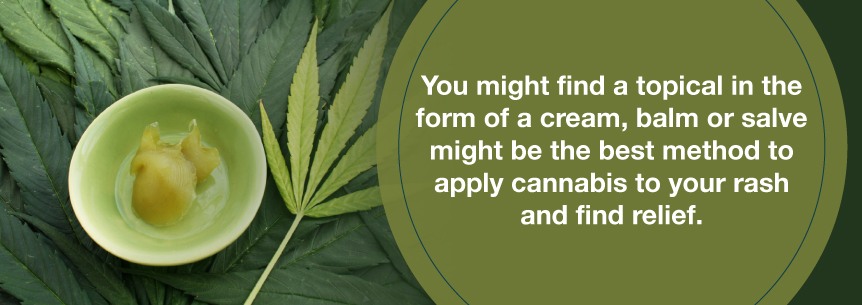
Before you begin your medical marijuana for dermatomyositis journey, you’ll want to learn and understand your state laws. Then, if your state approves of medical cannabis for your qualified condition, your next step will be to find an approved cannabis doctor and dispensary. You can find both at MarijuanaDoctors.com.
Find A Doctor Find A Dispensary